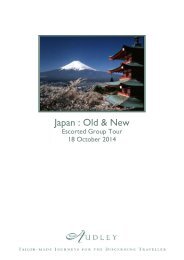Download - Audley Travel
Download - Audley Travel
Download - Audley Travel
Create successful ePaper yourself
Turn your PDF publications into a flip-book with our unique Google optimized e-Paper software.
Food display outside izakaya restaurant<br />
Chef serving Japanese fast food<br />
Some highlights of Japanese cuisine<br />
Rice<br />
The staple of every Japanese meal. Steamed<br />
gohan (cooked rice) is served as a side dish to<br />
traditional breakfasts, lunches and dinners, and<br />
no meal is complete without it.<br />
Miso soup<br />
Another staple accompaniment to most meals,<br />
misoshiru is a light soup made from miso<br />
(soybean) paste, often served with tofu and<br />
spring onions. Miso soup is slurped from the<br />
bowl, using chopsticks rather than a spoon.<br />
Noodles<br />
Udon and soba are two of the main types of<br />
noodle found in the Japanese diet. Udon are<br />
thick wheat noodles usually served in a broth<br />
with tempura or vegetables or as an<br />
accompaniment to meat and fish main dishes.<br />
Soba noodles are thinner but are served in the<br />
same way. A popular way to eat either udon or<br />
soba is zaru, meaning basket, where the noodles<br />
are served chilled on a wicker basket with a<br />
topping of soy sauce, grated ginger, wasabi paste<br />
(a type of fiery green horseradish), shredded nori<br />
seaweed and spring onions.<br />
Sushi and Sashimi<br />
Sushi comes in several forms, of which<br />
nigiri-zushi (a slice of raw fish placed on top of<br />
a ball of vinegared rice), maki-zushi (a sushi roll<br />
wrapped in seaweed) and inari-zushi (rice in a<br />
pocket of sweet, fried tofu) are the most<br />
common. Some variations involve cooked fish,<br />
such as eel and prawn. The most common and<br />
cheapest way of eating sushi is by finding a<br />
kaiten-zushi bar. Here you sit at the counter and<br />
chose your dishes from the revolving conveyor<br />
belt – prices are indicated by the colour of the<br />
plate and range from around a £1 to over £5,<br />
depending on the cut and grade of the fish.<br />
You can also ask the chef to prepare a favourite<br />
dish or, if you are not sure what to choose,<br />
you can ask for a sushi moriawase (a mixed set).<br />
Sashimi is simply raw fish served without rice<br />
and is often used as an appetiser for main meals.<br />
Both sushi and sashimi are served with shouyu<br />
(soy sauce) for dipping, wasabi paste and slices<br />
of pickled gari (ginger).<br />
Tempura<br />
Tempura is the general name for any vegetable,<br />
portion of fish or prawn fried in a light, crispy<br />
batter. Tempura is usually served in a<br />
lacquerware box with dipping sauce and grated<br />
daikon (white radish) or tempura salt, and<br />
comes with rice and crunchy pickles.<br />
Yakiniku<br />
Yakiniku or ‘Korean barbeque’ as it is also known<br />
is a sociable dining experience. Various cuts of<br />
beef including rump, tongue, stomach and fillets<br />
are dipped in a rich dark sauce and cooked at<br />
your table (by you) on a small grill. Originating<br />
in Korea, the meat dishes can be accompanied<br />
by kimchi – spicy Korean pickles – and bibinba,<br />
which is a tasty and healthy Korean rice dish<br />
cooked quickly to lock in freshness, often served<br />
in sizzling stone bowls so hot that they actually<br />
cook the ingredients in front of you.<br />
Ramen<br />
Now a common feature on the Japanese<br />
menu, ramen is Chinese in origin. There are<br />
countless variations, especially regionally, but<br />
the basic concept of ramen is a bowl of noodles<br />
in a flavoured broth (most commonly miso<br />
paste or soy sauce) topped with vegetables and<br />
meat, usually pork. Ramen is best accompanied<br />
by delicious gyoza – steamed or grilled<br />
Chinese dumplings stuffed with vegetables<br />
and pork or prawn.<br />
Okonomiyaki<br />
Okonomiyaki is a quick lunch option cooked<br />
on an iron plate, and is often called a Japanese<br />
pancake. A variety of ingredients including<br />
batter, cabbage, pork, prawns and egg are<br />
squashed together to form a flat, filled patty and<br />
then served with a rich sauce and mayonnaise.<br />
Kaiseki<br />
Perhaps the most elegant and esteemed meal in<br />
Japan, kaiseki ryori originates from Kyoto and is<br />
the original accompaniment to a tea ceremony.<br />
It now consists of many light courses of a range<br />
of delicacies, chosen for their seasonality and<br />
freshness. Presentation is highly important when<br />
serving kaiseki dishes. Prices range from a<br />
reasonable £25-30 per person to in excess of<br />
£200 a head, depending on the quality and size<br />
of meal you choose.<br />
Japanese pub<br />
An izakaya is the Japanese version of a pub and<br />
serves a wide selection of casual dining options,<br />
both Japanese and western, along with lots of<br />
beer and sake. Izakaya restaurants are great fun,<br />
good value and easy to spot – outside, they will<br />
often have red lanterns bearing the name of the<br />
restaurant and extensive picture menus, and<br />
there will be plenty of noise coming from within.<br />
Okonomiyaki ‘pankakes’<br />
www.audleytravel.com/japan ● 01993 838 210 ● Food 21

















